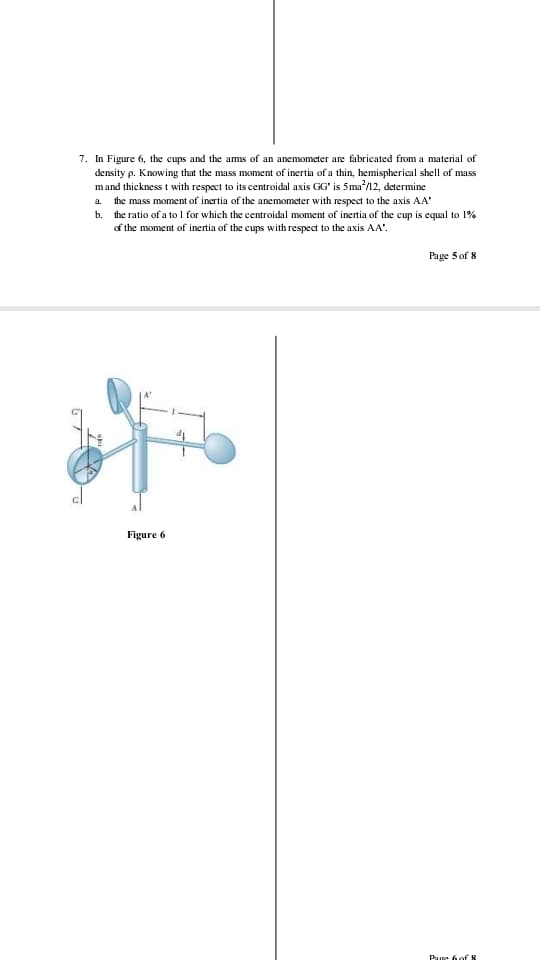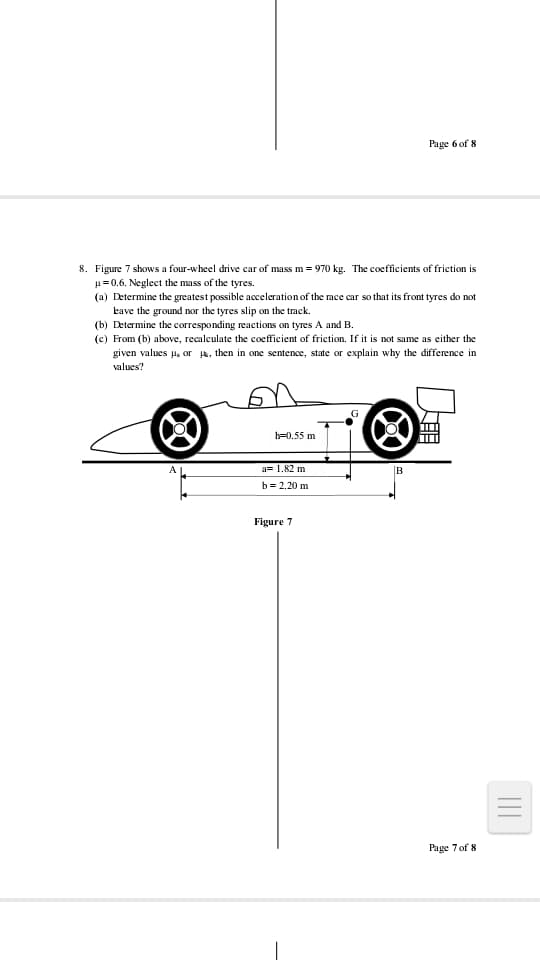7. In Figure 6, the cups and the ams of an anemomcter are fabricated from a material of density p. Knowing that the mass moment of inertia of a thin, hemispherical shell of mass mand thickness t with respect to its centroidal axis GG' is 5ma'n2, determine a the mass moment of inertia of the anemometer with respect to the axis AA' b. the ratio of a to I for which the centroidal moment of inertia of the cup is equal to 1% of the moment of inertia of the cups with respect to the axis AA'.
7. In Figure 6, the cups and the ams of an anemomcter are fabricated from a material of density p. Knowing that the mass moment of inertia of a thin, hemispherical shell of mass mand thickness t with respect to its centroidal axis GG' is 5ma'n2, determine a the mass moment of inertia of the anemometer with respect to the axis AA' b. the ratio of a to I for which the centroidal moment of inertia of the cup is equal to 1% of the moment of inertia of the cups with respect to the axis AA'.
International Edition---engineering Mechanics: Statics, 4th Edition
4th Edition
ISBN:9781305501607
Author:Andrew Pytel And Jaan Kiusalaas
Publisher:Andrew Pytel And Jaan Kiusalaas
Chapter7: Dry Friction
Section: Chapter Questions
Problem 7.49P
Related questions
Question
100%

Transcribed Image Text:7. In Figure 6, the cups and the ams of an anemometer are fabricated from a material of
density p. Knowing that the mass moment of inertia of a thin, hemispherical shell of mass
mand thickness t with respect to its centroidal axis GG' is 5ma'n2, determine
the mass moment of inertia of the anemometer with respect to the axis AA'
b. the ratio of a to l for which the centroidal moment of inertia of the cup is equal to 1%
of the moment of inertia of the cups with respect to the axis AA'.
a.
Page 5 of 8
Figure 6
Pane 6 of8

Transcribed Image Text:Page 6 of 8
8. Figure 7 shows a four-wheel drive car of mass m = 970 kg. The coefficients of friction is
u=0.6. Neglect the mass of the tyres.
(a) Determine the greatest possible acceleration of the race car so that its front tyres do not
kave the ground nor the tyres slip on the track.
(b) Determine the corresponding reactions on tyres A and B.
(c) From (b) above, recalculate the coefficient of friction. If it is not same as either the
given values H, or Hk, then in one sentence, state or explain why the difference in
values?
h=0.55 m
a= 1.82 m
B
b = 2.20 m
Figure 7
Page 7 of 8
Expert Solution
This question has been solved!
Explore an expertly crafted, step-by-step solution for a thorough understanding of key concepts.
Step by step
Solved in 2 steps with 1 images

Knowledge Booster
Learn more about
Need a deep-dive on the concept behind this application? Look no further. Learn more about this topic, mechanical-engineering and related others by exploring similar questions and additional content below.Recommended textbooks for you

International Edition---engineering Mechanics: St…
Mechanical Engineering
ISBN:
9781305501607
Author:
Andrew Pytel And Jaan Kiusalaas
Publisher:
CENGAGE L

International Edition---engineering Mechanics: St…
Mechanical Engineering
ISBN:
9781305501607
Author:
Andrew Pytel And Jaan Kiusalaas
Publisher:
CENGAGE L